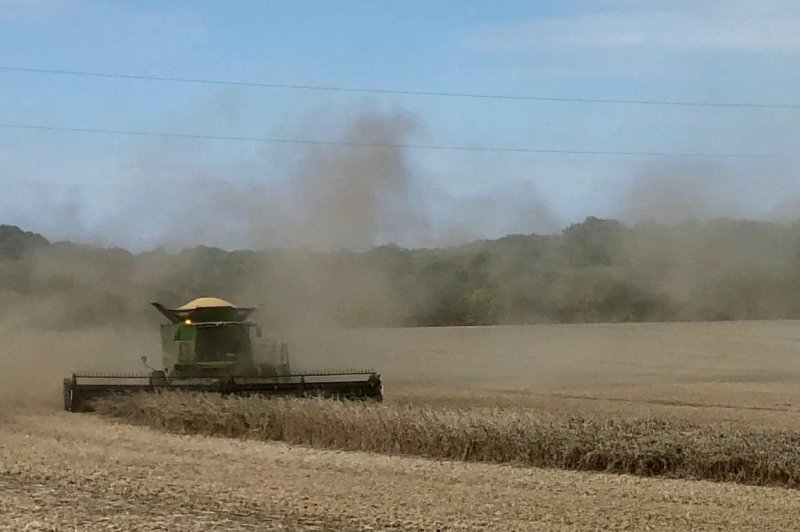Soybean futures prices dipped below $8 per bushel for the first time since December 2008 following Friday's U.S. tariff escalation on $200 billion of Chinese imports. Photo by Jessie Higgins/UPI
EVANSVILLE, Ind., May 10 (UPI) -- As America's agricultural commodity prices dropped further after Friday's tariff escalation on $200 billion of Chinese goods, President Donald Trump vowed to buy more domestic farm products for international humanitarian aid.
"We will buy agricultural products from our Great Farmers, in larger amounts than China ever did, and ship it to poor & starving countries in the form of humanitarian assistance," Trump said in a series of tweets Friday morning. "Our Farmers will do better, faster, and starving nations can be helped."
But agricultural experts were quick to point out that this tactic is unlikely to help the agricultural sectors that are most impacted by the enduring trade conflict.
Those commodities -- corn and soy -- are not used for human consumption.
America is the world's largest producer of corn and soybeans, but the vast majority of the varieties American farmers grow are processed into animal feeds, oils and ethanol.
"It's not as easy as people might think to buy a bunch of commodities and ship them somewhere," said Todd Hubbs, a clinical assistant professor of agricultural commodity markets at the University of Illinois. "This is not sweet corn. People don't eat it. It's high in starch and low in sugars and it doesn't taste good."
Trump did not mention any other kind of farm aid in the tweets. Agriculture Secretary Sonny Perdue and Vice President Mike Pence alluded to additional help this week, without details.
"You can be very confident that President Trump and I and our entire administration are going to look for ways to provide additional support to American farmers that would be impacted by the negotiations or uncertainty in our relationship with China," Pence told the farming news site Agri Pulse on Thursday. "And those discussions have already taken place."
On Friday morning, Perdue tweeted:
"Just spoke with [Trump] -- while China may backtrack, [Trump] is steadfast in his support for U.S. farmers and directed USDA to work on a plan quickly. [Trump] loves his farmers and will not let them down!"
Before Friday, Perdue had repeatedly said the USDA would not provide additional tariff aid to farmers in 2019 after the roughly $12 billion in trade aid it has already distributed.
Since the trade war between the United States and China began in July, the prices for America's soybeans and corn have dropped dramatically.
Soybeans were most affected because China was the United States' biggest soy importer -- by far. Roughly a third of all the soy grown in the United States was shipped to China. So, after the country placed a high retaliatory tariff on American soy, shipments to China all but stopped, sending prices plummeting and leaving large quantities of soy sitting in bins on farms across the Midwest with nowhere to go.
"Before the tariffs, business was good this year," said Jack Scoville, a market analyst for The PRICE Futures Group in Chicago. "It was a big change, and not an altogether welcome one. As a broker, my commissions are derived from the agricultural market here and overseas, and I can tell you, business is down."
Prices rebounded slightly over the spring, as progressing trade talks made it seem increasingly likely a deal could be reached and normal trade restored.
That all changed Sunday night, when Trump threatened to increase tariffs yet again. Soybean futures prices dropped immediately, from about $8.30 per bushel Sunday to $8.18 Monday. Friday morning, after the tariff increase took effect, they dropped still further, opening at $8.10 and then hitting a low of $7.95, according to the Chicago Mercantile Exchange.
Prices have not been this low since December 2008.
"This puts us back to where we were before the trade negotiations started," said Grant Kimberley, director of market development for the Iowa Soybean Association, who also grows corn and soybeans.
The United States produces more corn and soy than it can use annually. The soybean industry is actively looking for new trading partners to buy America's backlog of unused soy, Kimberley added.
"But the demand from rest of the world combined is not as much as the Chinese market," Kimberley said. "It means we're going to have significantly more soybeans in storage again this year."
The longer the trade conflict continues, the harder it will be for farmers to sell off their soy stores.
"It just compounds itself," Kimberley said. "Farmers understand the bigger issues at play, but it is also challenging for them. They are bearing the brunt of this trade war. They are the tip of the spear. So it's difficult. You can't make plans for the future; you're wondering how you're going to pay your bills. Because prices are well, well below the cost of production at this point. And that's across agriculture, not just soybeans."















